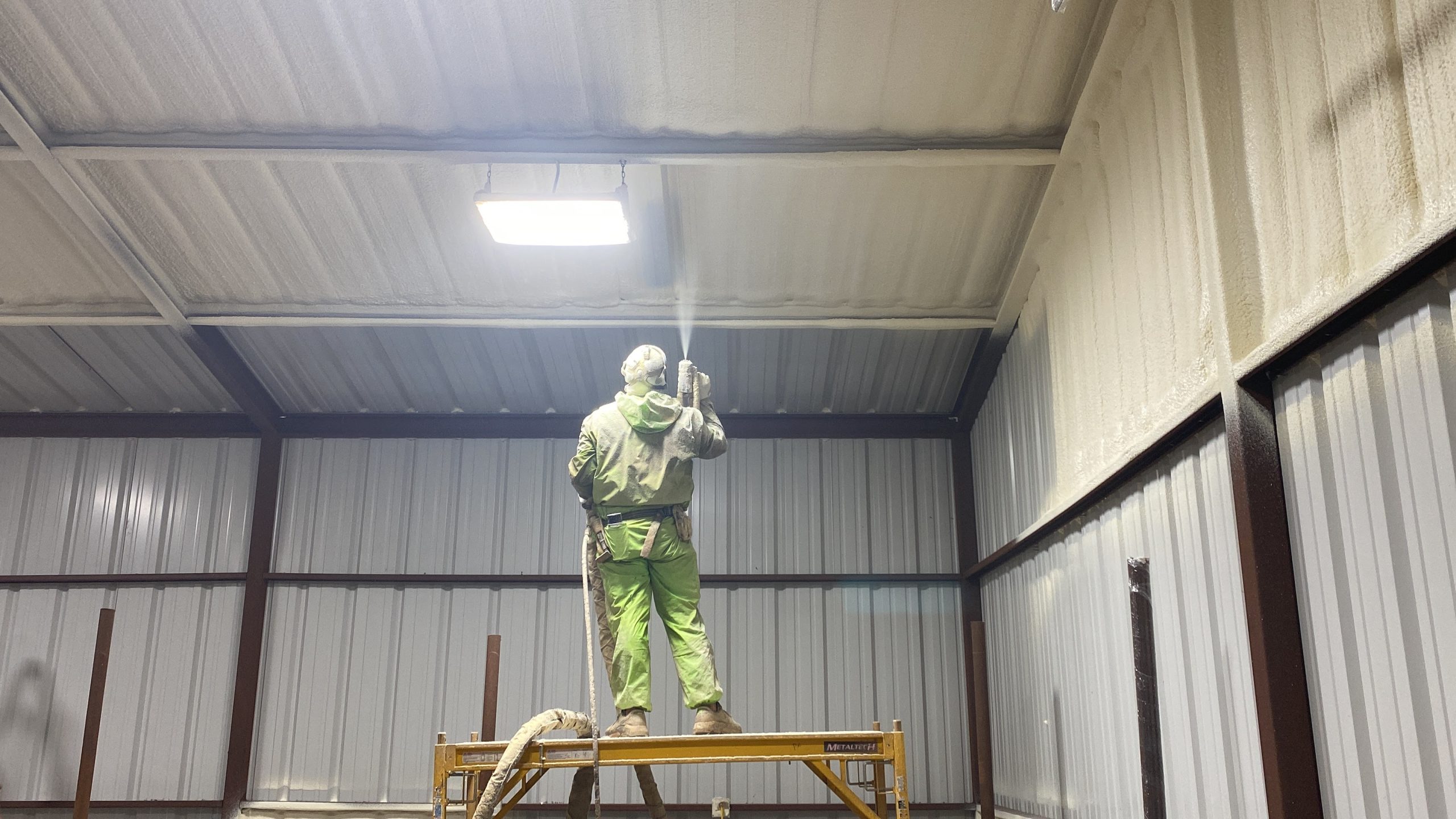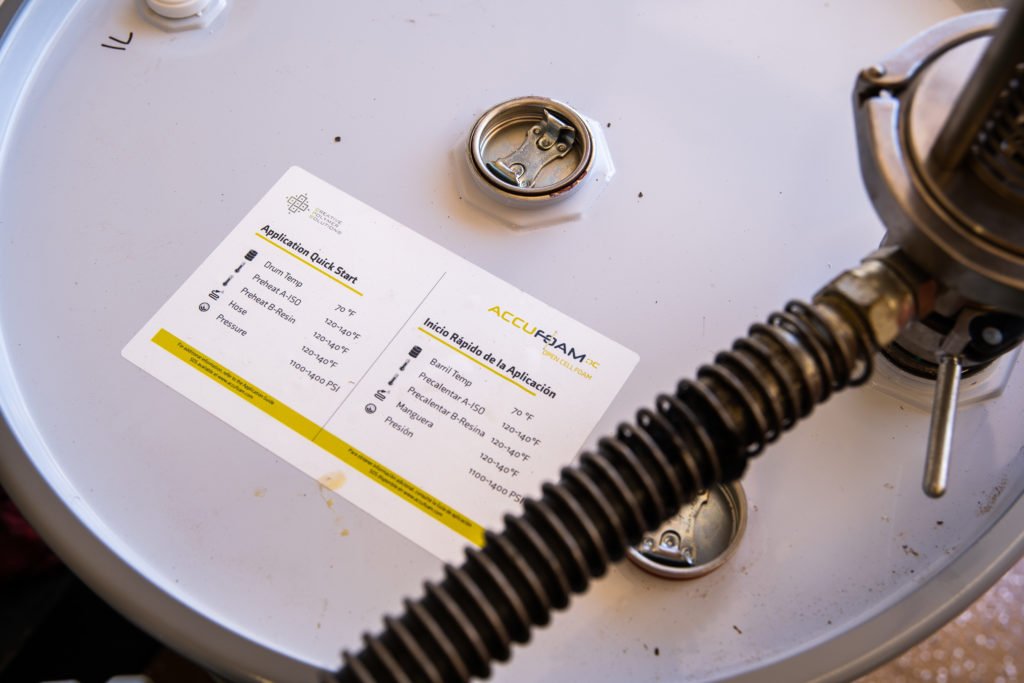
With summer winding down to fall and, ultimately, winter, there is no better time to start considering best practices when applying spray foam in colder months.
Although applying spray foam insulation in colder months poses its own set of challenges, professionals can benefit from valuable tips and tricks when working on such projects.
Continue reading to discover our recommendations for effectively applying spray foam insulation in cold weather!
Temperature and Moisture Considerations
Proper preparation and thoughtful planning are essential when it comes to applying spray foam insulation in cold weather conditions.
Understanding the specific formulation needed for the prevailing ambient and substrate temperatures is of utmost significance to ensure a successful and efficient insulation job.
Product Storage Temperature
Different products have their own precise and unique temperature requirements based on their chemical composition.
Nevertheless, it’s valuable to be aware of the general temperature guidelines for storing spray foam insulation products.
Typically, spray foam drums should be maintained at temperatures ranging between 60°F and 90°F, depending on the specific product. It’s important to emphasize that this is a broad recommendation, and for precise details, always refer to your product’s technical data sheet.
Storing your spray foam within the appropriate temperature range offers several benefits when you’re ready to use it on-site.
By adhering to the correct temperature range, you’ll achieve optimal coverage per gallon, expedite project commencement, maximize yield, and enjoy an overall smoother spraying experience with fewer interruptions.
Ambient Air Temperature
The ambient air temperature refers to the temperature of the air within the area where you intend to install spray foam insulation.
Spray foam insulation offers versatility in application across a wide range of ambient air temperatures, thanks to its customizable chemical composition on a batch basis. However, it’s important to note that these various formulations typically perform optimally within a temperature range spanning from 20°F to 95+°F.
Substrate Temperature and Moisture Content
Substrate temperature pertains to the temperature of the surface onto which you are applying the spray foam insulation, whether it be plywood, metal, or another material.
Similar to the requirements for ambient air temperatures, spray foam insulation should be applied to substrates within a temperature range of 20°F to 95+°F.
Furthermore, it is important to note that for all Accufoam products, the moisture content of construction substrates should not exceed 19%. To assess the moisture conditions on your surfaces, a straightforward moisture meter can be employed as a useful tool.
General Tips for Installation in Cold Weather
To effectively apply spray foam insulation during winter conditions, a practical approach is to utilize a specialized winter blend of spray foam, which is designed to function optimally in challenging temperature environments.
Companies like Accufoam offer tailor-made formulations explicitly crafted to operate within specific temperature parameters.
Accufoam’s closed-cell spray foam exhibits versatility across a range of ambient air temperatures, thanks to its various chemical formulations, including the following winter-specific options:
- Polar Grade
- Winter Grade
- Regular
- Summer Grade
- Summer+ Grade
However, it’s important to note that open-cell spray foams lack this level of customization. In such instances, it becomes essential to ensure that your storage, ambient air, and substrate temperatures are maintained within appropriate ranges.
Below, we provide some valuable tips on achieving this critical aspect of successful insulation in winter.

Tips to Keep Your Spray Foam Drums at the Optimal Temperature in Storage:
- Ensure temperature monitoring is in place across your storage facility, rig, and project setup areas by installing thermometers in each of these spaces.
- Use a laser thermometer to accurately gauge the temperature of the product inside your drums.
- Elevate your drums off the ground within your storage facility, truck, or project setup by placing them on wooden pallets to create a buffer.
- Implement safe heating practices within your storage facility, rig, or project setup area by using appropriate heaters.
Accufoam’s open-cell spray foam can be heated directly in the drums when working in cold weather or during the mixing process. To achieve this:
If your proportioner is equipped with circulation lines, you can use it to warm up the drums (not exceeding 90°F) by circulating the foam through the machine back into the drums. Ensure that the machine heaters are set no higher than 110°F during this operation. It’s important to note that this procedure should only be carried out with open-cell insulation; closed-cell foams should not be recirculated.
Now that we’ve covered methods for maintaining drum temperature, let’s explore strategies for ensuring your ambient air and substrate temperatures remain within the optimal range.
Tips for Keeping Your Ambient Air and Substrate Temperature Optimal in the Winter
Maintaining appropriate ambient air and substrate temperatures is a straightforward process, but it demands careful execution.
Here’s the straightforward part: You can employ indoor heating systems and portable heaters to elevate the temperature within your installation area and ensure it stays within the optimal range.
However, it is imperative to ensure these heaters are switched off before you start spraying. Interaction between the spray foam fumes and heating equipment can generate toxic emissions and potentially harm other machinery.
In essence, it’s a matter of adhering to best practices for indoor heating. Always consult your product’s safety and technical data sheets for precise guidance.
To ensure that your spray foam achieves the same quality during curing as it did during the application, it’s advisable to maintain the elevated temperature within the building for at least 24 hours following the spraying process.
The Accufoam Difference
As mentioned above, Accufoam offers a range of temperature-specific formulas for our closed-cell spray foams, ensuring that your product performs precisely as needed during your work.
Additionally, our open-cell product is exceptionally reliable, making it easy to achieve success with straightforward temperature control in your workspace.
Accufoam manufactures spray foam insulation that is rigorously tested under real job site conditions. This means you can confidently spray, knowing that our products excel in on-site scenarios, not just in laboratory settings.
Furthermore, our products come with our quality control guarantee and unwavering customer support. We work to empower our contractors to become the trusted source for clients seeking dependable results that enhance building safety, comfort, and energy efficiency.
If you’re interested in learning more about the advantages of spray foam installation in the winter, don’t miss our blog on the topic.
Reach out to us today, and we’ll connect you with a professional installer in your area. You can call us at (205) 440-4996 or fill out our online contact form to get started.


